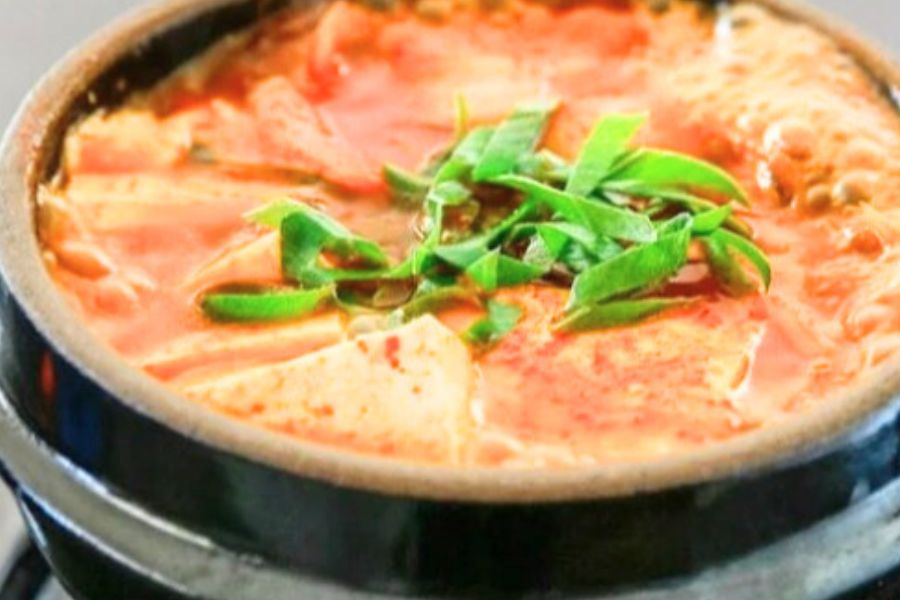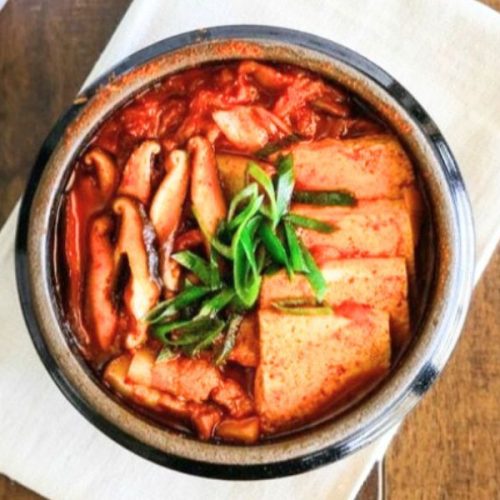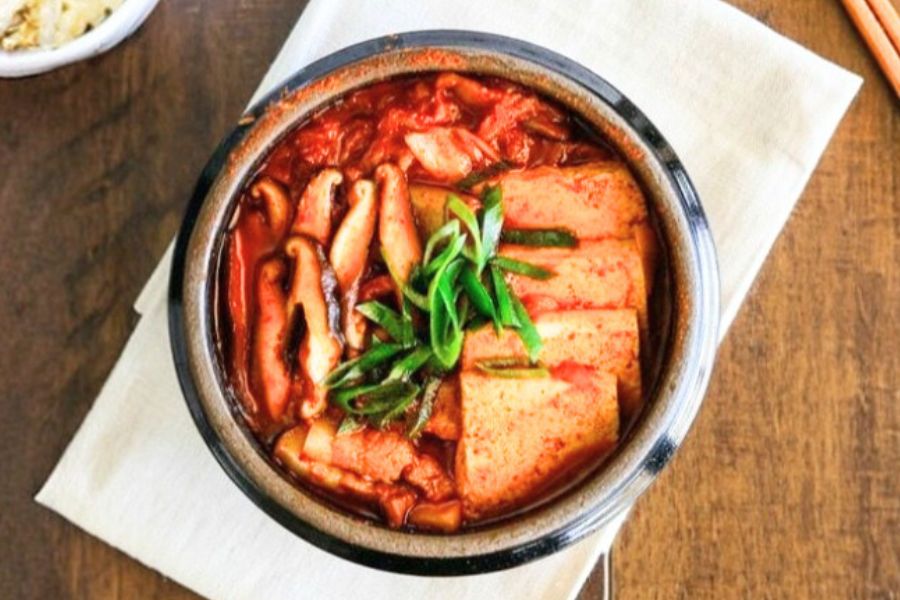Kimchi Jjigae is the ultimate comfort stew, offering a perfect balance of bold flavors and wholesome nutrition.
Its combination of protein-rich pork belly and plant-based protein from tofu ensures a filling, muscle-supporting meal, while the fermented kimchi delivers probiotics that aid digestion and gut health.
Low in carbohydrates but rich in vitamins and minerals, this stew is also packed with fiber from mushrooms and vegetables, making it a well-rounded option for everyday meals.
Beyond its nutritional benefits, it’s a quick and satisfying dish that comes together in just 30 minutes, making it ideal for busy weeknights, easy meal prep, or even cozy weekend dinners.

The rich, savory broth infused with garlic, chili, and soy highlights the essence of Korean cuisine, making this stew both comforting and exciting to the palate.
Must-Have Tools for Perfect Results
Clay Pot or Korean Ttukbaegi
Perfect for cooking kimchi jjigae evenly while retaining heat and flavor. Its heat retention makes it versatile for soups and stews.
Chef’s Knife
Essential for precise slicing of pork, tofu, mushrooms, and vegetables. A sharp knife ensures consistent cooking and elegant presentation.
Mixing Bowl
Ideal for combining the jjigae base ingredients before adding them to the stew. A high-quality bowl can also serve as a prep station for sauces and marinades.
Measuring Spoons & Cups
Ensures accurate measurements of chili flakes, soy sauce, and water for balanced flavors. Essential for consistent results in everyday cooking.
Skillet (Optional)
Helps to pre-cook kimchi for extra depth of flavor, but also doubles as a multipurpose pan for sautéing, frying, or browning meats.

30-Minutes Kimchi Jjigae Recipe
Equipment
- 1 clay pot or medium pot (1–1.5 L capacity)
- 1 skillet (optional)
- 1 Chef’s Knife
- 1 Cutting Board
- 1 Mixing Bowl
- Measuring cups and spoons
Ingredients
Meat
- 180 g pork belly skinless, cut into bite-size pieces
- 1 Tbsp sweet rice wine mirin
- 3 sprinkles ground black pepper
Kimchi & Vegetables
- 3/4 cup aged kimchi 2–3 weeks old, bite-size pieces
- 30 g 1/4 small brown onion, thinly sliced
- 5 g 1/2 stalk green onion, thinly sliced
- 50 g 2 small shiitake mushrooms, thinly sliced
- 150 g firm tofu cut into 1 cm slices
- 1 cup water
Jjigae Base
- 1 Tbsp Korean chili flakes gochugaru
- 1 Tbsp soy sauce
- 1 tsp Korean chili paste gochujang
- 1/4 tsp minced garlic
- 3 sprinkles ground black pepper
Instructions
- Prepare the Pork Belly: Begin by cutting your skinless pork belly into bite-sized pieces, roughly 2–3 cm each, to ensure they cook evenly and remain tender. Place the pork in a medium mixing bowl, then add 1 tablespoon of sweet rice wine (mirin) and sprinkle with a pinch of black pepper. Using clean hands or a spoon, mix the pork thoroughly so every piece is lightly coated. Cover the bowl with plastic wrap and let it marinate at room temperature for 15 minutes.This step allows the alcohol in the mirin to tenderize the meat while enhancing its natural flavor.
- Prepare the Vegetables and Tofu: While the pork is marinating, prepare the kimchi, mushrooms, onions, green onions, and tofu. If your kimchi is not pre-cut, chop it into bite-sized pieces for easy eating. Thinly slice the brown onion and remove the stems from the shiitake mushrooms before slicing them.Cut the tofu into 1 cm thick rectangles or your preferred shape. Keep the green onions separate; they will be added at the very end for a fresh, bright flavor. Setting aside the ingredients now ensures a smooth, organized cooking process.
- Pre-Cook the Kimchi (Optional but Recommended): In a medium skillet, over medium heat, lightly sauté the kimchi until it becomes soft and slightly fragrant, about 5–7 minutes. This caramelizes the natural sugars in the kimchi, intensifying its flavor and adding depth to the stew. If your cooking pot is large enough, you can skip this step and cook the kimchi directly in the pot.
- Assemble the Stew: Take a clay pot or medium-sized pot with at least a 1–1.5 liter capacity. Place the marinated pork belly at the bottom of the pot in an even layer.Then carefully layer in the sautéed (or raw) kimchi, sliced onions, mushrooms, and tofu. Pour in 1 cup of water to create the base for the stew. In a small mixing bowl, combine 1 tablespoon Korean chili flakes, 1 tablespoon soy sauce, 1 teaspoon Korean chili paste, 1/4 teaspoon minced garlic, and a few sprinkles of black pepper. Stir this jjigae base until fully mixed, then pour it evenly over the other ingredients in the pot.
- Cook the Stew: Place the pot over medium-high heat and bring it to a gentle boil. Once boiling, reduce the heat to medium and allow the stew to simmer. Gently stir the broth occasionally, spooning the liquid over the tofu and pork to ensure all ingredients absorb the rich flavors evenly. Cook for approximately 10–15 minutes, or until the pork is thoroughly cooked and tender.The stew should be aromatic, with the flavors of kimchi, chili, and soy blending beautifully.
- Add Green Onions and Final Touches: Once the meat is cooked, stir in the thinly sliced green onions.This final step adds a burst of color, freshness, and subtle sharpness that complements the deep, savory flavors of the stew. Give the pot a gentle final mix to combine everything without breaking the tofu. Taste the broth and adjust seasoning if necessary—add a bit more soy sauce for saltiness or chili flakes for extra heat.
- Serve and Enjoy: Ladle the steaming kimchi jjigae into individual bowls and serve immediately alongside a bowl of warm steamed rice. For a traditional Korean experience, accompany the stew with banchan (small side dishes). The stew can be enjoyed hot, and any leftovers taste even better the next day as the flavors continue to meld.
Notes
- Marinate pork belly for at least 15 minutes to ensure tender, flavorful meat.
- Use aged kimchi (2–3 weeks old) for a richer, more tangy flavor.
- Pre-cooking kimchi in a skillet is optional but enhances depth and aroma.
- Adjust spice levels by increasing or reducing gochugaru and gochujang.
- Gently stir tofu to prevent it from breaking apart during cooking.
- Leftover stew tastes even better the next day as flavors intensify.
- Use a clay pot or heavy-bottomed pot to retain heat and evenly cook the stew.
Chef’s Secrets For Authentic Flavor
The key to an authentic, rich-tasting kimchi jjigae lies in layering flavors carefully.
Start with properly aged kimchi to achieve a tangy, fermented depth that defines the stew. Marinating the pork belly in rice wine softens the meat and balances the umami flavors.
Cooking the kimchi briefly before adding it to the pot enhances caramelized notes that enrich the broth.
Using a clay pot or heavy-bottomed cookware ensures even cooking and keeps the stew hot longer, allowing flavors to meld beautifully.
Finally, adding the green onions at the end preserves their vibrant aroma, creating a perfectly balanced dish every time.
Serving Suggestions For Every Meal
Kimchi jjigae is best served piping hot, paired with freshly steamed white or brown rice.
Complement it with traditional Korean banchan such as pickled vegetables, seasoned spinach, or marinated bean sprouts for a complete meal.
For a lighter twist, serve alongside a simple cucumber salad or a bowl of plain rice noodles to soak up the flavorful broth.
This stew is versatile enough for lunch, dinner, or even a cozy weekend brunch when you want comfort food with minimal effort.
Storage Tips For Long-Term Enjoyment
Kimchi jjigae stores beautifully in the refrigerator for up to 3 days. Allow the stew to cool slightly, then transfer to an airtight container.
When reheating, do so gently over medium heat to avoid breaking the tofu, and add a splash of water or broth if it has thickened.
This stew can also be frozen for up to 2 months; portion it into individual containers for easy, ready-to-go meals.
Thaw overnight in the refrigerator and reheat slowly on the stove for best results.
Frequently Asked Questions Answered
1. Can I use other meats instead?
Yes! Chicken thigh, beef brisket, or even seafood like tuna or shrimp can replace pork belly. Adjust cooking times accordingly to ensure the protein is fully cooked but still tender.
2. How spicy is kimchi jjigae normally?
Traditional kimchi jjigae has a moderate level of heat. You can adjust the spice by adding more or less Korean chili flakes (gochugaru) or chili paste (gochujang) to suit your preference.
3. Can I make this recipe vegetarian?
Absolutely. Substitute pork with extra-firm tofu, mushrooms, or tempeh, and use vegetable broth instead of water to maintain rich flavor while keeping it plant-based.
4. Is it okay to use fresh kimchi?
Fresh kimchi will work but won’t have the same depth of tangy, fermented flavor. If using fresh kimchi, consider letting it sit for a few days to develop more acidity before cooking.
5. Can I meal prep kimchi jjigae?
Yes, this stew is excellent for meal prep. Store in airtight containers in the refrigerator or freezer. It reheats well and flavors often improve after sitting, making it ideal for busy weeknight lunches or dinners.
This recipe has been adapted and simplified from the original version by mykoreankitchen. We’ve refined the steps for a smoother cooking experience and added helpful notes, nutrition insights, and essential kitchen tools to make it even easier for home cooks.

